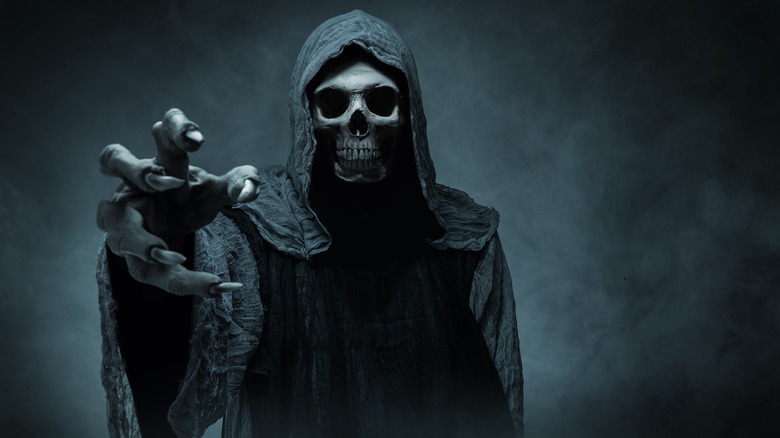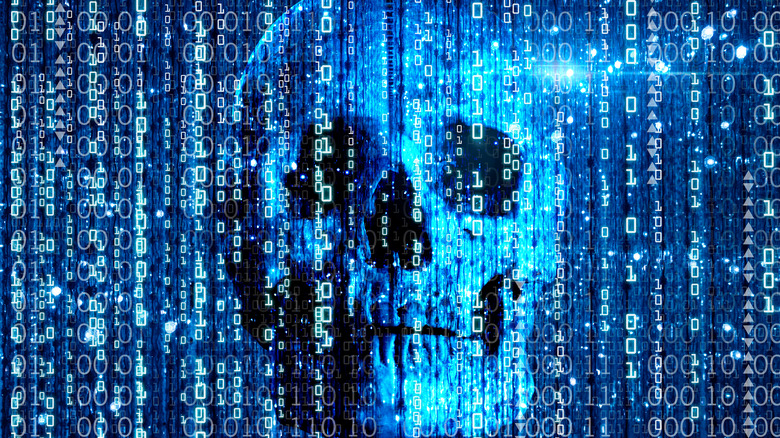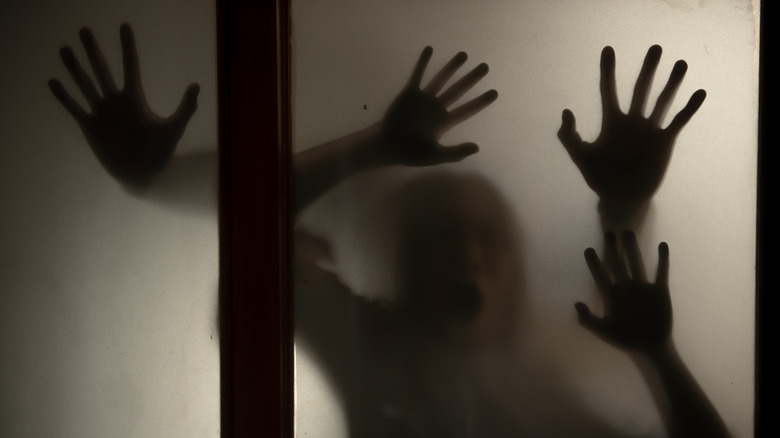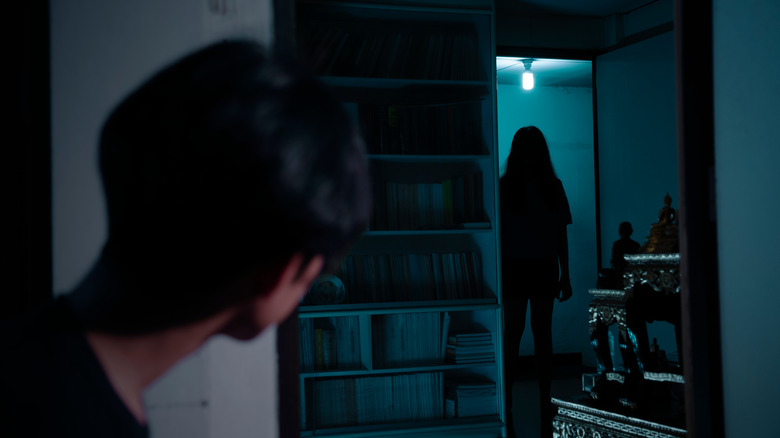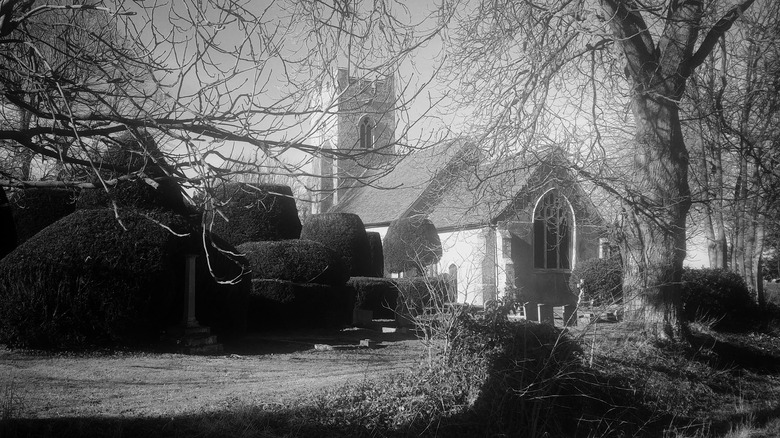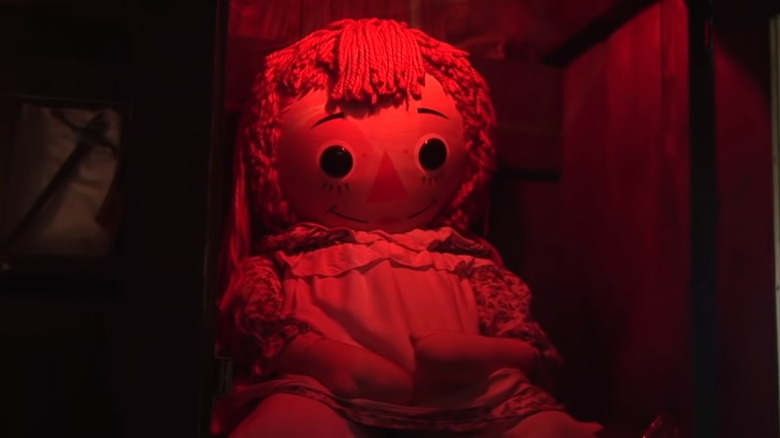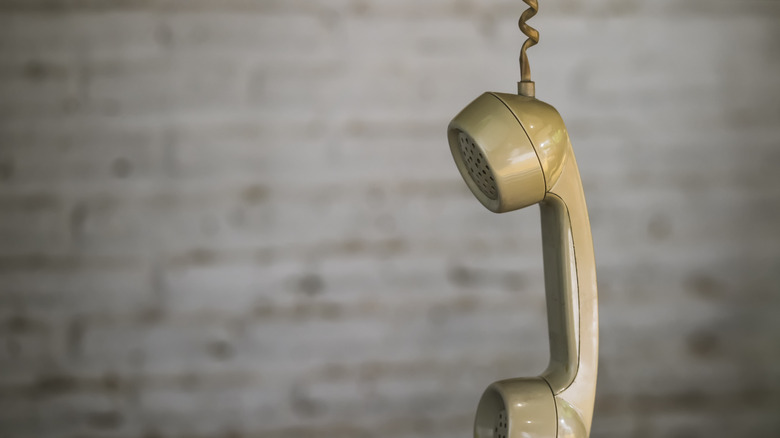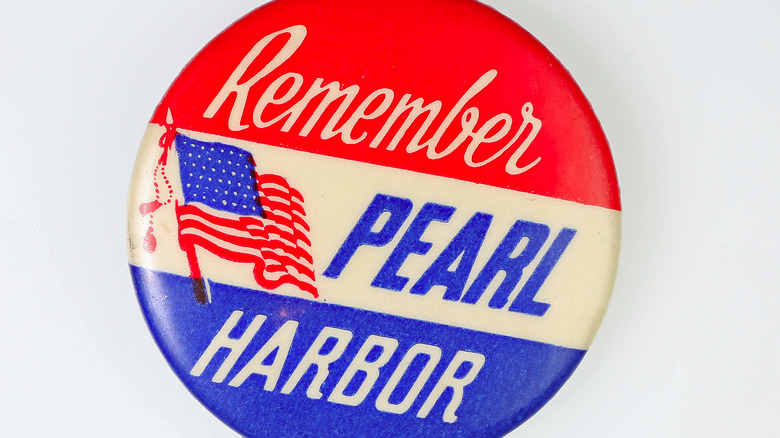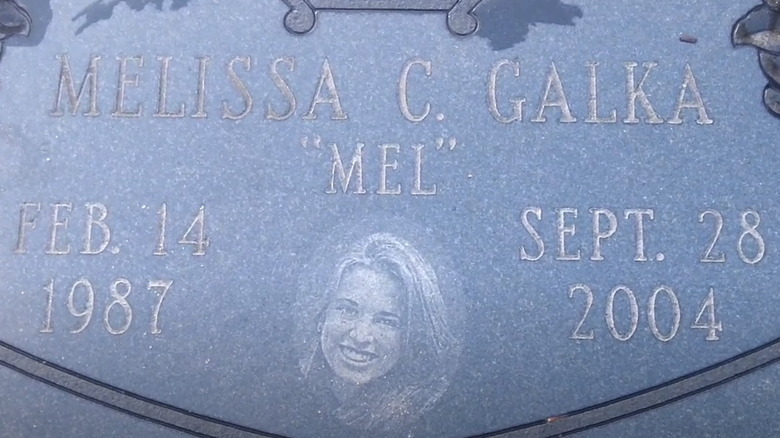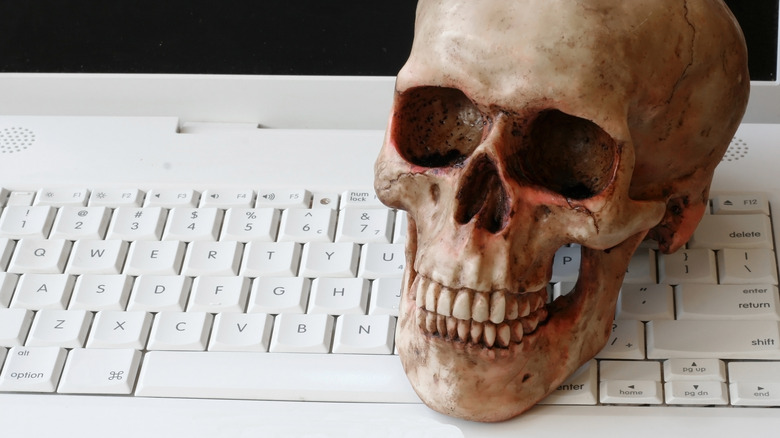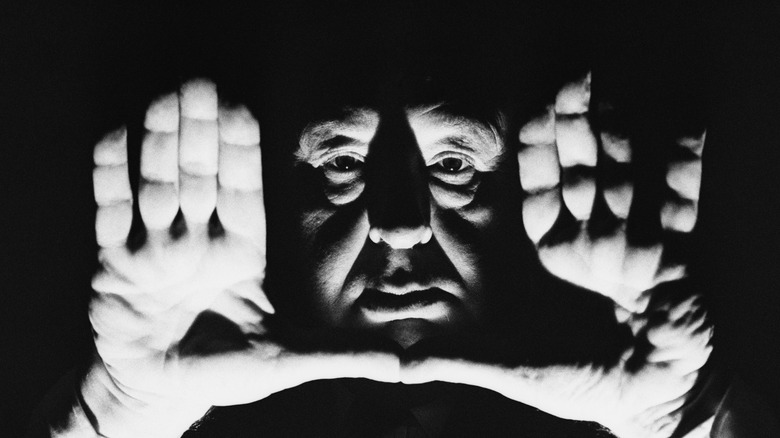The Most Chilling Messages People Received Beyond The Grave
The question of life after death is the supreme mystery of the human condition. For centuries, the possibility of an existence beyond death has fascinated religious scholars, scientists, artists, writers, and common people of every race and culture. In the Western world, communication with the deceased became a cultural obsession with the rise of spiritualism in the late 19th and early 20th centuries. Luminaries ranging from author Sir Arthur Conan Doyle to magician Harry Houdini to inventor Thomas Edison vied to prove or disprove the existence of the spirit world.
Two decades into the 21st century, the fascination with ghosts, hauntings, and the afterlife continues unabated. The popularity of reality TV shows as "Ghost Adventures" led to an explosion of interest in the paranormal, with countless amateur ghost hunting groups springing up all over the world. In popular culture, the films of "The Conjuring" franchise, based on the real-life case files of ghost hunters Ed and Lorraine Warren, have become Hollywood blockbusters that introduce new audiences to notorious hauntings such as the Enfield Poltergeist.
Yet for some, communication with the dead is more than a mere weekend diversion or fascinating philosophical puzzle. To those who have received messages from the veil, the supernatural is sometimes a frightening reality. From the touching to the terrifying, here are some of the most chilling messages people have received from beyond the grave.
A ghostly phone call saved author Dean Koontz's life
As the man behind such terrifying bestsellers as "Watchers" and "Hideaway," author Dean Koontz is no stranger to fictional supernatural terrors. However, as documented in "Dean Koontz: A Writer's Biography," in September 1988, the writer had a real life encounter with the supernatural that even his fertile imagination couldn't prepare him for. On that day, Koontz was hard at work in his office when he heard his phone ring. Picking up the phone, the author heard a faraway female voice say "Please, be careful!" Startled by the cryptic warning, Koontz asked the caller to identify herself. The voice would only repeat its admonition before fading away to silence. Stunned, Koontz suddenly realized that the caller was his mother, who had died 20 years before.
Two days later, Koontz visited his father, Raymond Koontz, at the retirement home where he lived. A violent schizophrenic alcoholic, Raymond had been an abusive father to Dean and had repeatedly threatened to kill his son. Still, Dean financially supported his father for the last 14 years of his life. During the visit, Raymond came within inches of murdering his son. Raymond pulled a knife on Dean, managing to stab through his son's shirt. The struggle spilled into the hallway before Dean finally disarmed his father. The author again narrowly avoided death when the police arrived and found him holding his father's knife. Fortunately, Dean dropped the blade before the officers fired on him.
A high tech warning
According to "Talking to the Dead" by George Noory and Rosemary Guiley, the supernatural entered the computer age when Manfred Boden, a German cabinet maker, received a haunting message via his Commodore CBM 8032 in 1980. As Boden entered information into a biorhythm program, he noticed letters and lines of text begin to change by themselves. Eventually, a coherent message formed: "I am here, you will die, Manfred, 1982 accident August 16, 1982. Yours, Klaus." With that message, Boden experienced the first known paranormal encounter by computer. Soon, another message appeared: "HEART ATTACK, HI HI."
Boden went into a two-year downward spiral of paranoia as his presumed death date approached. Yet, the day came and went without incident. Understandably rattled by the messages, Boden initially assumed that he was in contact with a recently deceased friend. Boden consulted paranormal researcher Ernst Senkowski, who advised him that no deceased person would attempt to scare a living friend. Still, Senkowski determined that the messages were indeed paranormal in origin.
Boden continued to communicate with spirits and experimented with taped Electronic Voice Phenomena (EVP) throughout the early 1980s. Eventually, Boden began receiving unexplained telephone calls from both the dead and entities that described themselves as energy beings. The strange calls culminated with a rash of poltergeist activity in Boden's home.
The mysterious case of Charles E. Peck
On September 12, 2008, a Metrolink commuter train carrying 225 passengers crashed head on into an oncoming Union Pacific freight locomotive in the Los Angeles suburb of Chatsworth. One of the deadliest train accidents in southern California history, the Chatsworth crash claimed the lives of 25 people and injured over 135. As detailed by Reuters, the train's driver, Robert Martin Sanchez, 46, was at fault. Sanchez had apparently been texting in the moments before the collision. Distracted by his phone, he failed to heed trackside signals that would have warned him of the oncoming freight train.
Among the dead was 49-year-old Charles E. Peck. A recently divorced father of three grown children, the Salt Lake City, Utah native was on his way to Van Nuys, California, for a job interview. Recently engaged, he was moving to California to start a new life with his fiancé, Andrea Katz. Katz was on her way to the Metrolink station when she heard the news of the deadly crash on the radio. Initially, Katz held out hope that Peck had survived the accident. For 11 hours after the accident, Peck's cell phone placed 35 calls to his family and loved ones. When they answered, they were met with static. Attempts to return the calls went to voicemail. Peck's body was retrieved from the wreckage approximately one hour after the last call. Rescuers determined from the condition of his body that he died on impact. Peck's cell phone was never found.
Ominous threats from a poltergeist
In 2006, a couple from South Shields, England, began experiencing increasingly disturbing paranormal phenomena in their home. Identified only as Marc and Marianne in "The Black Book of Modern Myths: True Stories of the Unexplained," the couple were plagued with a variety of typical poltergeist activity ranging from opening and closing doors and unexplained knocks to furniture moving across the floor.
As documented in "Phantom Messages" by Jimmy Petonito and William J. Hall, the apparently supernatural activity took a sinister turn when the poltergeist turned its attention to toys belonging to the couple's 3-year-old son. Animated by an unseen force, the toys performed a "ghastly dance" around the room. Soon, Marc and Marianne found themselves dodging objects thrown by the angry entity. Most disturbing of all, the malevolent force left threatening, expletive-filled messages such as "Die b****!" "You're dead," and "RIP" on their son's magnetic doodle board.
As the haunting continued, the entity became more sophisticated in its methods of communication. Vulgar, untraceable emails and texts followed, promising Marianne that she was "Going to die today" and "I'll come for you when you are asleep, b****." When the couple was out, Marianne would receive mysterious calls on her cell phone. The source of the silent calls displayed on her phone's screen was the landline in the couple's locked and empty house.
The phenomena continued for nearly a year before ceasing as suddenly as it started.
The ghost who identified her killer
On February 21, 1977, the Chicago Fire Department was called to extinguish a blaze in the apartment of 47-year-old respiratory therapist Teresita Basa. After putting out the flames, the firefighters stumbled upon a grisly scene. As detailed by Chicago Now, Basa's body was discovered under her mattress, and a kitchen knife protruded from her chest.
With no signs of forced entry, investigators determined that Basa must have known her assailant, but the scant physical evidence led detectives to a dead end. After a couple of months, the case went cold. It seemed Basa's killer had gotten away with murder.
Later, Remebios "Remy" Chua, a co-worker of Basa's at Edgewater Hospital, witnessed a terrifying apparition of her deceased colleague in a locker room. The dead woman also appeared in her dreams, where she showed Chua the face of her killer — a hospital porter named Alan Showery.
Basa's otherworldly influence over Chua wasn't limited to nightmares. Falling into a trancelike state, Chua began speaking with Basa's voice, revealing more and more details about the murder. "Tell them Al came to fix my television, and then he killed me," Chua allegedly said.
Chua's husband, an influential doctor, was able to convince a skeptical Chicago detective to listen to his wife's claims. An ensuing investigation traced jewelry stolen from Basa's apartment to Alan Showery's girlfriend. Initially claiming no knowledge of the crime Showery eventually pled guilty and was sentenced to 22 years in prison for murder and armed robbery.
Writing on the wall at Borley Rectory
Dubbed "the most haunted house in England," Borley Rectory was built in the early 1860s by Reverend Henry D. Bull. Adjacent to Borley Church, the rectory was home to a succession of clergymen and their families until it was damaged by fire in 1939. While living there, the Bull family was witness to a variety of weird occurrences in the home including unexplained footsteps, rappings, and apparitions.
Borley's next occupants were Reverend G. Eric Smith and his wife, who moved in in late 1928. Initially skeptical of the house's reputation, the Smiths had their first uncanny experience just prior to moving in. As detailed in "Poltergeists, Hauntings, and the Haunted" by David C. Knight, Mrs. Smith (whose first name is not detailed) discovered a human skull wrapped in brown paper and tied with string while cleaning the cupboards. The skull's origins were never determined. During the Smiths' stay, poltergeist activity increased dramatically. They left Borley Rectory in summer 1929.
The haunting reached a crescendo with the arrival of Reverend Lionel Foyster and his wife, Marianne, in 1930. Shrieks, shattered windows, and physical assaults were just some of the phenomena the Foysters experienced. Much of the activity centered on Marianne, who was addressed directly in eerie messages such as "Marianne get help" scrawled on the refectory's walls. When Marianne responded that she didn't understand, she was answered with "Marianne light mass prayers." The Catholic tenor of many of the messages fueled speculation that Foyster may have been in communication with the spirit of a murdered nun named Marie Lairre.
Creepy notes from Annabelle
Thanks to Hollywood, Annabelle may be the most famous haunted doll in history. However, her true story is quite a bit different than what's been portrayed in the movies. As detailed in "The Demonologist: The Extraordinary Career of Ed and Lorraine Warren," the real Annabelle is a typical Raggedy Ann Doll, far from the frightening porcelain monstrosity depicted in "The Conjuring" films. In 1970, 25-year-old nursing student Donna Jennings received Annabelle as a birthday gift from her mother. Almost immediately, Jennings and her roommate Angie Stapleton noticed that there was something unsettling about the doll.
Unaided, the doll moved from room to room. It also possessed the ability to write. About a month after receiving Annabelle, Jennings and Stapleton began to find notes written on parchment paper. Scrawled in a childish hand, the messages read "Help us" and "Help Lou," apparently referring to Stapleton's boyfriend, Lou Carlo. Deepening the mystery, Jennings and Stapleton kept no parchment in their home.
With the help of a medium, the roommates concluded that the doll was inhabited by the ghost of a 7-year-old girl named Annabelle Higgins. Still, the doll's behavior became increasingly sinister. Paranormal investigators Ed and Lorraine Warren determined that Annabelle was actually controlled by a malevolent, inhuman spirit. The Warrens took possession of the doll and it remains locked in a case in their Connecticut museum to this day.
A chilling phantom phone call
For a brief time, Viola Tollen of Indianapolis, Indiana, enjoyed a friendship with her young neighbor Ruby Stone. Sadly, their relationship was cut short when Ruby died at the tender age of 7. Nevertheless, the friends would speak again.
As documented in Andrew Honigman's "True Tales of Ghostly Encounters," one evening, just before dusk, Tollen's phone rang. Upon answering she was greeted by the voice of a child. Although she couldn't quite place the voice, it seemed familiar.
"They told me I could not telephone but I just did, didn't I?" the small voice said. "I know your voice, but who are you?" Tollen replied."You know me," the voice answered, "I am Ruby!" Stunned, Tollen said "Thank you and goodbye." As she dropped the phone, she heard the caller say "Thank you, too."
Although Tollen's experience with the paranormal was shocking, she came to cherish the memory of one last conversation with Ruby. "I am careful to whom I tell this story, but the telephone call from beyond remains a rare treasure in my memory," Tollen told Honigman.
Prophetic graffiti from beyond?
December 7, 1941, was a dark moment in United States History. The surprise attack by Japanese forces on the U.S. naval base at Hawaii's Pearl Harbor killed 2,400 Americans and left the fleet in ruins, according to History.
"Remember Pearl Harbor!" became a rallying cry for the nation and a call to arms for thousands of young men who signed up for military service in the wake of the attack. In the years since the war, the phrase has taken on a tone of solemnity as Americans continue to commemorate that fateful day.
However, as documented in "Strange But True: Mysterious and Bizarre People" by Thomas Slemen, those words would present an intriguing mystery to the people of Owensville, Indiana, when they appeared on a sidewalk on December 7, 1939 — two years to the day before the attack. Authorities at first assumed the writing was the work of a kid bent on a bit of harmless vandalism. At the time of the incident, locals puzzled over the message, but really didn't give it much thought. Yet, with the United States' entry into World War II, memories of the mysterious graffiti took on a ominous tone. The identity of the phantom writer was never discovered.
A daughter's devotion transcends the grave
In 2004, 17-year-old Melissa Galka was a senior at Granby Memorial High School in Granby, Connecticut. Popular and outgoing, she planned to study interior design and business management in college. However, graduation would never come for Melissa Galka. Just after midnight on the morning of Saturday, September 25, Galka lost control of her car and crashed into a tree. Seriously injured, she died three days later.
Yet, as reported by the Hartford Courant, the Galka family couldn't shake the eerie feeling that Melissa was somehow still with them. "She started doing things like ringing the doorbell, changing TV channels, turning lights on and off," Melissa's father Gary Galka said.
Communicating with Melissa became an obsession for Gary Galka. A talented electrical engineer, Galka's quest led him to invent and market a number of devices for detecting ghostly activity, including the P-SB7 Spirit Box, a high-frequency scanning device that he claims allows the dead to speak with the living in real time, and the Mel Meter, which measures fluctuations in electromagnetic fields and temperature.
As documented in a 2012 episode of "Ghost Adventures," paranormal investigators Zak Bagans, Aaron Goodwin, and Nick Groff ,along with Gary Galka, attempted to contact Melissa in the Galka home. During the show, Melissa speaks through a Spirit Box, saying "Hi, dad" and "Miss you and all" and referring to Bagans as a "friend."
Emails from a dead man
When 32-year-old Jack Froese died suddenly of heart arrhythmia in June 2011, his friends and family were left reeling. Yet, as shocking as Froese's early death was, nothing could prepare them for what happened a few months later.
In November, Froese's best friend, Tim Hart, received a curious email. Sent from Froese's account with the subject "I'm watching," the message read, "Did you hear me? I'm at your house. Clean your f***ing attic!!!" "I turned ghost white when I read it," Hart told the BBC. Just before Froese died, he had joked about the untidy state of Hart's attic.
Another email sent to Froese's cousin, Jimmy McGraw, commented on an ankle injury McGraw had suffered following Froese's death. "I'd like to say Jack sent it, just because I look at it as he's gone, but he's still trying to connect with me. He's still trying to tell me things, to move along, to feel better," McGraw said.
Responses to the emails went unanswered. Only Froese knew his password, and friends and family have determined that it is unlikely that his email was hacked.
The mystery that fascinated Alfred Hitchcock
One night in January 1934, the mother of sailor Arne Gandy received a phone call at 3:00 a.m. The voice on the line was that of a strange man. "The kid is here, and for God's sake forgive him and give him another chance," the mysterious voice on the other end of the line said.
As detailed in "Unbelievable" by Stacy Horn, Mrs. Gandy also claimed that she heard the voice say to someone else, "When shall we operate, doctor?" before adding, "All right, now that he's forgiven, we'll send him home." When she frantically asked the man to identify himself, he answered with hollow laughter. Other voices, sighs, and groans could be heard in the background. She also heard the faint voice of her son calling out, "Oh, Mama help me."
Later that morning, authorities fished the body of Arne Gandy from San Francisco Bay. The coroner determined that Gandy had been in the water for more than 48 hours. Alfred Hitchcock called the case of Arne Gandy "one of the five most baffling real-life mysteries of our generation," telling "Coronet's" Keith Monroe, "If I made it into a movie no one would believe it."
